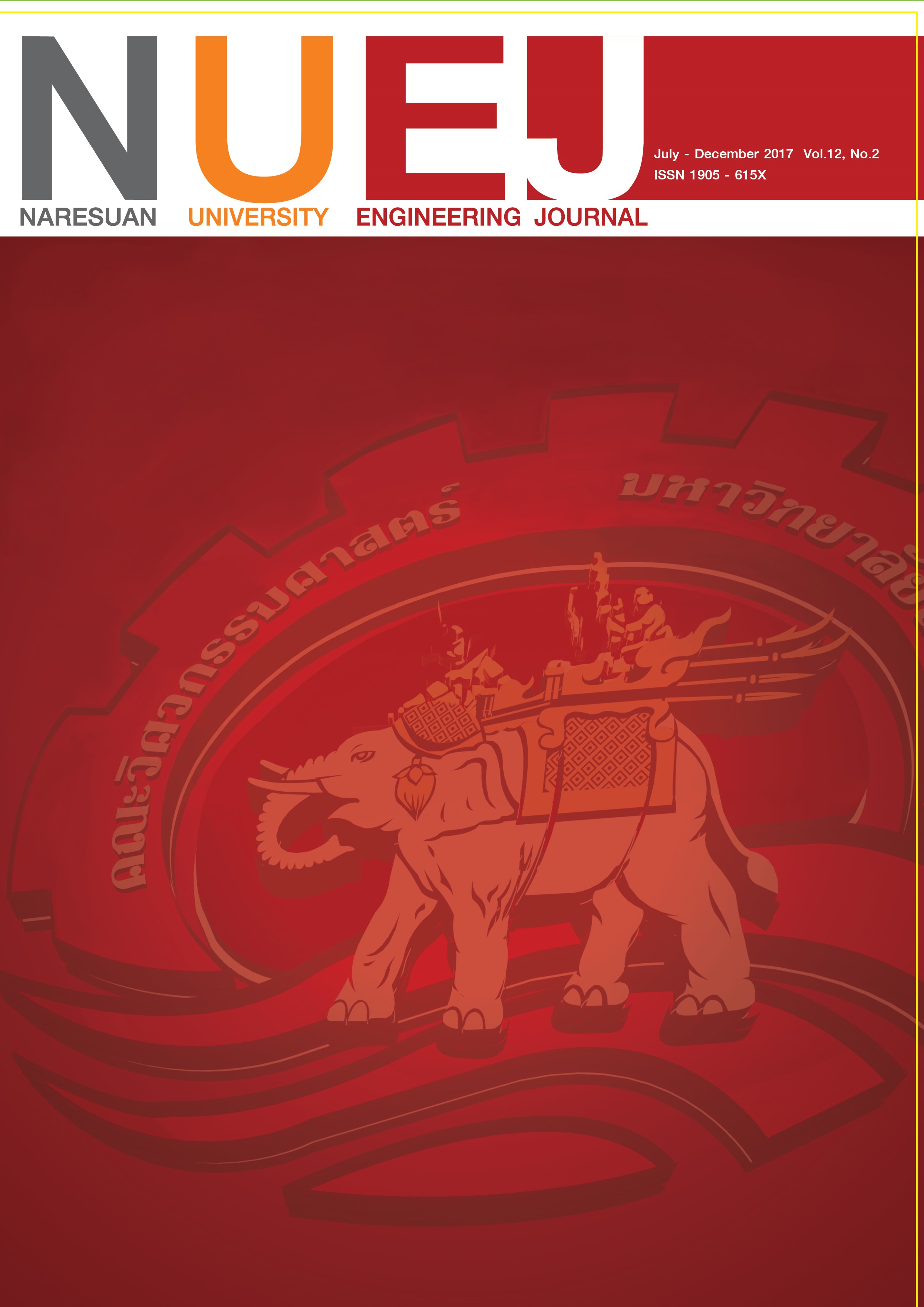แบบจำลองการไหลซึมแบบ 3 มิติ เพื่อการวิเคราะห์เสถียรภาพของลาดดินไม่อิ่มน้ำ 3-D Seepage Modeling for Analyzing Unsaturated Slope Stability
Main Article Content
Abstract
Landslide problem due to heavy rainfall is one of the major natural disasters in Thailand. Most of landslides often occurred on unsaturated slope in the mountainous area. In general, main causal factor of landslide is the changing of moisture content in the soil mass while rainfall. Whenever rainfall occurring, soil moisture content increased, soil shear strength decreased affect to slope instability and possible failure. This research investigated the effect of rainstorms on moisture content and slope stability with 3-D numerical seepage model and Infinite slope stability model in unsaturated soil. There are 90 cases by considering return period, duration and pattern of rainfall in Mae Phrong – Mae Phun watershed, Uttaradit province, northern Thailand, This is the area where severe landslides occurred in May 2006. The result shown that, the average value of moisture content of whole area before rainfall is 75% (Degree of Saturation) and the highest value from all cases is 86%. Moreover, when return period and duration of rainfall are higher, moisture content is higher. For effect of rainfall pattern, the pattern has more intensity on last day cause moisture content to highest. Average factor of safety (F.S.) of the whole area before rainfall is 3.55. The highest F.S. from all cases is 1.85, which is related to moisture content change. Finally, the comparison of areas with F.S. less than 2.0 is correspond to the landslide area for 73.81%
Article Details
References
[2] Mairaing, W., & Kunsuwan, B. (2005). Landslide Condition and Problems in Thailand. Paper presented at the EIT-JAPAN-AIT Join Workshop 2005, Geo-Risk Engineering and Management, Bangkok, Thailand. [in Thai]
[3] Soralump, S., Pungsuwan, D., Chantasorn, M., & Inmala, N. (2010). Landslide Hazard Management in Patong Municipality Using Geotechnical Engineering Method. Paper presented at the 15th National Convention on Civil Engineering, Ubon Ratchathani, Thailand. [in Thai]
[4] Soralump, S., & Nuimak, T. (2013). Estimation of Statistical Critical Rainfall Envelope for Landslide Warning. Paper presented at the 18th National Convention on Civil Engineering, Chiang Mai, Thailand. [in Thai]
[5] Tepparnich, J. (2010). Mechanical Behaviour of Soil in Laplae Area of Uttaradit Province with Applications to Landslide. (Master’s Thesis), Kasetsart University, Thailand. [in Thai]
[6] Thaiyuenwong, S. & Soralump, S. (2012). Rain-Infiltration Model for Landslide Hazard Assessment. Paper presented at the 17th National Convention on Civil Engineering, Udon Thani, Thailand. [in Thai]
[7] The Chaipattana Foundation. (2016). Research and Development for Landslide Protection on Highland Slope:Geotechnical Engineering Modelling for Prediction of Landslide Prone Area (Subproject 7). Bangkok, Thailand. [in Thai]
[8] Department of Mineral Resources (DMR) (Cartographer). (1985). Geological Map of Thailand 1:250,000. Retrieved from http://www.dmr.go.th/dmr_data/downloadmap/ geologicmap/NE47-11.zip [in Thai]
[9] Engman, E. T. (1986). Roughness coefficients for routing surface runoff. Journal of Irrigation and Drainage Engineering, 112(1), 39-53.
[10] Department of Mineral Resources (DMR). (2006). Map of areas affected by landslide in Ban Pha Mub Uttaradit Province. Bangkok, Thailand. [in Thai]
[11] Fredlund, D. G., & Rahardjo, H. (1993). Soil mechanics for unsaturated soils: John Wiley & Sons.
[12] Mairaing, W. (2008). Landslide problems and warning by geotechnical methods. Paper presented at the 26th Conference of the ASEAN Federation of Engineering Organization, Bangkok, Thailand.
[13] Mairaing, W. & Thaijeamaree, N. (2004). Unsaturated Soil Strength for Mountain Slope Stability Analysis. Paper presented at the 9th National Convention on Civil Engineering, Phetchaburi, Thailand. [in Thai]
[14] Fredlund, D. G., & Morgenstern, N. R. (1977). Stress state variables for unsaturated soils. Journal of Geotechnical and Geoenvironmental Engineering, 103(ASCE 12919).
[15] Jotisankasa, A. (2012). Unsaturated Soil Mechanics (1 ed.). Bangkok: Pre-One. [in Thai]
[16] Bishop, A. W. (1959). The principle of effective stress. Teknisk ukeblad, 39, 859-863.
[17] Thai Meteorological Department (TMD). (n.d.). Season of Thailand. Retrieved from https://www.tmd.go.th/info/ info.php?FileID=53 [in Thai]
[18] Department of Mineral Resources (DMR). (2010). Knowledge of Landslides. Retrieved from http://www.dmr.go.th/download/Landslide/what_landslide1.htm [in Thai]
[19] Harp, E. L., Held, M. D., Castañeda, M. R., McKenna, J. P., & Jibson, R. (2002). Landslide hazard map of Tegucigalpa, Honduras. US Geological survey open-file report, 02-219.

